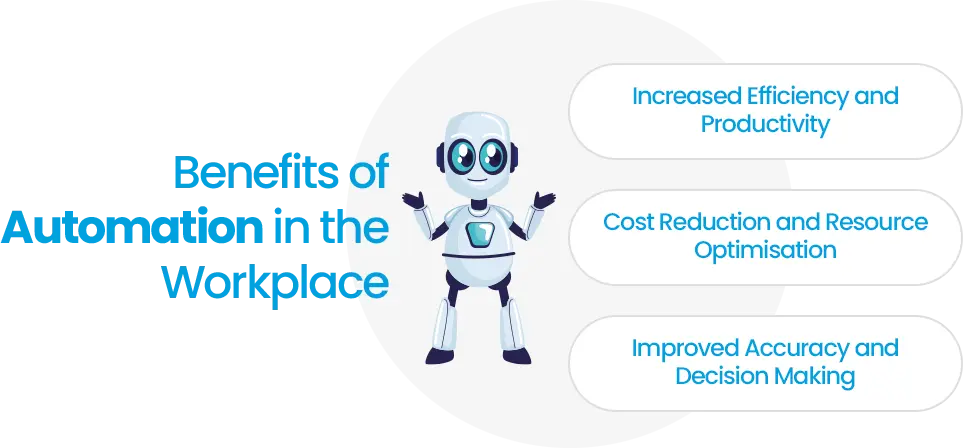In today’s technological landscape, the implementation of AI in businesses is revolutionising operations, decision-making, and customer interactions. From the Industrial Revolution’s mechanisation to the computerisation of the digital age, businesses have always strived for optimisation.
The development of large language models (LLMs)—like OpenAI’s GPT-4o is currently driving workplace automation to unprecedented levels. Automation enabled by AI and LLM has several benefits, including improved performance, reduced expenses, and increased production. It also frees up human workers to concentrate on more strategic and creative work.
This blog will explore the transformative impact of AI and LLMs on businesses, highlighting both the benefits and challenges of automation and providing insights into the future of AI in the business world.
What are Large Language Models (LLMs)?
Large Language Models (LLMs) are a subset of artificial intelligence that is dedicated to producing, comprehending, and modifying human language. They are built using deep learning techniques, particularly neural networks, and are trained on vast amounts of text data to perform a wide range of language-related tasks.
Key Features of LLMs

1. Scale and Size
LLMs are characterised by their large number of parameters, often ranging into the billions. This vast amount of data is thought to contribute to their ability to understand complex language patterns and subtle nuances.
2. Versatility
They can perform a variety of tasks, including but not limited to language translation, text summarisation, sentiment analysis, question answering, and text generation.
3. Contextual Understanding
Long text sections are easier for LLMs to comprehend and retain coherence over, which gives their outputs a more contextually relevant and human-like appearance.
4. Transfer Learning
Once trained on large datasets, LLMs can be fine-tuned for specific tasks with relatively smaller datasets, making them adaptable and efficient for various applications.
5. Pre-Trained and Fine-Tuned Models
LLMs often come pre-trained on general data and can be further fine-tuned for domain-specific applications, enhancing their accuracy and relevance.
6. Natural Language Generation
They may produce writing that is frequently identical to human writing, both culturally relevant and grammatically accurate.
Examples of Popular LLMs
- ChatGPT-4o by OpenAI
- BERT by Google
- T5 by Google
- Gemini by Google
- XLNet by Google/CMU
- LLaMA by Facebook
- Megatron-Turing NLG by NVIDIA and Microsoft
Challenges in Implementing AI in Business
>> Data Quality and Availability
Ensuring that pertinent, high-quality data is accessible is essential. Inaccurate AI insights and outputs might result from poor data.
>> Integration with Existing Systems
Seamlessly integrating AI tools with legacy systems can be complex and time-consuming, often requiring significant technical adjustments.
>> High Implementation Costs
The initial investment in AI technology, infrastructure, and training can be substantial, posing a barrier for many businesses.
>> Skill Gaps and Training
A lack of trained employees capable of creating, deploying, and overseeing AI systems may impede advancement. Continuous training is necessary.
>> Data Privacy and Security Concerns
Strong security measures and governance are necessary to protect sensitive data and guarantee compliance with privacy laws.
>> Change Management
Resistance to change from employees can slow down AI adoption. Effective change management strategies are needed to ease the transition.
>> Scalability Issues
It can be difficult to scale AI solutions from pilot programmes to large-scale deployments; this calls for careful resource allocation and planning.
>> Ethical and Bias Considerations
AI systems may unintentionally reinforce biases found in training data, raising ethical issues that need to be addressed.
>> Maintenance and Updates
AI systems require regular updates and maintenance to remain effective, necessitating ongoing investment and technical support.
>> Measuring ROI
AI projects might have long-term or indirect advantages, making it challenging to demonstrate the return on investment (ROI) without using precise evaluation measures.
Steps for Effective AI Implementation in Business
Step 1 - Identify Business Needs
To make sure AI is in line with corporate strategies, evaluate areas where it can be useful and establish clear goals and objectives.
Step 2 - Choose the Right AI Tools
To guarantee long-term benefits, research and choose artificial intelligence technologies that meet your company’s demands, paying particular attention to scalability and integration capabilities.
Step 3 - Data Preparation
Collect and clean relevant data to ensure quality and accuracy, as high-quality data is crucial for effective AI performance.
Step 4 - Staff Training
Employees should be given training courses on AI to improve their AI literacy and feel at ease using new AI tools and technology.
Step 5 - Pilot Testing
Implement AI solutions on a small scale to monitor performance, gather feedback, and identify any issues before a full-scale rollout.
Step 6 - Evaluate and Optimise
Analyse the pilot test findings, change as needed, and optimise AI systems to boost productivity and accomplish goals.
Step 7 - Scale Up
Gradually expand AI implementation across the organisation, ensuring smooth integration with existing processes and minimising disruptions.
Step 8 - Monitor and Maintain
Maintaining current and efficient AI tools requires regular system updates, ongoing performance monitoring, and maintenance.
Step 9 - Ensure Compliance
Implement privacy and security laws, putting strong data governance procedures in place to safeguard confidential data.
Step 10 - Foster a Culture of Innovation
Encourage ongoing learning and adaptation, staying updated with the latest AI advancements and trends to maintain a competitive edge.
Automation of the Workplace through AI
Artificial intelligence (AI) is revolutionising automation across a wide range of industries and is also driving increases in efficiency and production. As AI technology advances and offers more sophisticated alternatives for boosting productivity and accelerating business expansion, it is anticipated that its application in the workplace will grow.
What is Workplace Automation?
The term “workplace automation” describes the use of technology to carry out operations and duties in a commercial setting with little to no human involvement. This can include a range of systems and tools designed to automate routine and repetitive activities, such as data entry, scheduling, and customer service interactions.
Key components of automation include software like robotic process automation (RPA), artificial intelligence (AI), machine learning algorithms, and advanced analytics. Together, these technologies improve productivity, save operating expenses, and streamline processes so that staff members may concentrate on more creative and strategic work.
Benefits of Automation in the Workplace

1. Increased Efficiency and Productivity
Automation takes over time-consuming and repetitive operations, which greatly increases production and efficiency.
2. Cost Reduction and Resource Optimisation
The implementation of automation processes can save a lot of money by reducing the need for human labour and eliminating errors.
3. Improved Accuracy and Decision-Making
Automated systems reduce the risk of human error, resulting in more accurate and reliable outcomes. Additionally, automation tools can analyse large datasets quickly, providing valuable insights and aiding in better decision-making processes.
Pros and Cons of Automation in the Workplace
Pros of Automation
- Speed: Automated systems are capable of doing jobs far more quickly than people, which results in higher production and speedier turnaround times.
- Scalability: Businesses can readily expand their operations through automation without experiencing a corresponding rise in labour costs.
- Reliability: Software and hardware operate reliably and predictably because they are fatigue-free and operate consistently.
- Streamlined Operations: Automation simplifies and streamlines complex processes, making operations more efficient and reducing bottlenecks.
- Enhanced Customer Experiences: Customer satisfaction can be increased overall by using automated technologies to deliver quicker, more reliable customer service.
Cons of Automation
- Job Displacement: The implementation of automation can lead to job losses as machines and software replace human workers in certain roles.
- Dependency on Technology: If automated systems malfunction or experience problems, an over-reliance on them may lead to risks.
- Security Risks: Cyberattacks can target automated systems, particularly those with network connections, which presents serious security issues.
- Ethical Considerations: The ethical implications of automation are significant, especially when it comes to job displacement and treating impacted individuals fairly.
- Managing Transition and Workforce Impact: Implementing automation calls for careful management, and labour implications—such as the need for employee retraining and reskilling—must be taken into account.
Balancing the Pros/Advantages and Cons/Disadvantages of Automation
To effectively balance the disadvantages and advantages of automation, businesses must adopt a strategic approach. This requires investments in employee upskilling and retraining to reduce job displacement, making sure cybersecurity safeguards are strong to safeguard automated systems, and keeping an adaptable infrastructure that can keep up with emerging technologies.
Organisations may reduce the negative effects of automation while maximising its positive effects by appropriately controlling these factors, which will eventually promote a more innovative, secure, and efficient workplace.
LLMs: The Powerhouse Behind Automation

LLMs are a type of AI trained on colossal amounts of text data. This gives them the ability to understand and speak human language with remarkable fluency. LLMs can be used in a commercial context to automate a wide variety of tasks, such as:
>> Content Creation
Reports, marketing text, and even artistic content like poetry or scripts can be produced by LLMs. As a result, human authors and marketers have more time to devote to more strategic projects like audience interaction and concept creation.
>> Customer Service
Chatbots powered by LLMs can answer customer queries, troubleshoot problems, and even handle basic transactions. This provides 24/7 customer support, offering a more convenient and efficient experience for customers.
>> Data Analysis
LLMs can be used to filter through large-scale datasets to identify trends and patterns, providing useful information to businesses. This makes it possible to make data-driven decisions in many industries, such as sales and marketing, operations, and finance.
>> Human Resources
Processes like organising interviews and evaluating resumes are automated by LLMs, freeing up HR staff members to concentrate on more strategic tasks like talent acquisition and employee development.
The Future of AI in Business: A Future Shaped by Human-Machine Collaboration
The future of work will undoubtedly involve a significant interaction between humans and AI. LLMs and other AI technologies will become increasingly sophisticated, taking over many repetitive and data-driven tasks. However, human skills like creativity, critical thinking, problem-solving, and emotional intelligence will remain crucial for success.
Here are some key trends to expect in the future of AI-powered work:
Rise of the Hybrid Workforce:
We are likely to see a rise in the hybrid workforce, where humans and AI collaborate on tasks. LLMs can automate routine tasks, freeing up human employees to focus on higher-level cognitive work and strategic initiatives.
Augmented Intelligence:
AI will be used to augment human intelligence, not replace it. LLMs can provide real-time data insights, automate administrative tasks, and offer suggestions to improve decision-making. This empowers humans to work more efficiently and effectively.
Focus on Human-Centric Skills:
As automation increases, the demand for human-centric skills like critical thinking, creativity, communication, and collaboration will rise. Businesses will need to invest in developing these skills in their workforce.
Lifelong Learning:
The pace of technological change will necessitate continuous learning and upskilling for employees. Businesses will need to provide opportunities for ongoing training and development to ensure their workforce remains adaptable and relevant in the AI era.
Evolving Jobs and Roles:
As AI transforms the workplace, traditional job roles will evolve, and new ones will emerge. Businesses will need to adapt their talent management strategies to identify and develop the skills needed for the future of work.
Conclusion
The rise of LLMs and AI marks a significant turning point in the landscape of business. While challenges exist, the potential benefits of AI in business are undeniable. By embracing a responsible and human-centred approach to AI implementation, businesses can harness the power of LLMs to create a future of work characterised by efficiency, innovation, and collaboration.
As we move forward, the key lies in striking a balance between automation and human capabilities, ensuring that AI empowers humans to perform at their best.
Embrace AI and LLMs to stay ahead of the curve and unlock a new era of business success.










